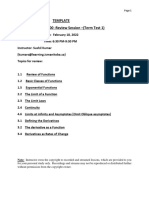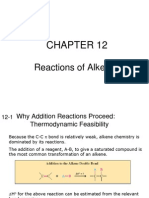Math 242: Exam 1 Review Questions
Uploaded by
superfr3shmMath 242: Exam 1 Review Questions
Uploaded by
superfr3shmMath 242 : Exam 1 Review Questions
The following list are questions which span the material weve covered over the rst three weeks
of the semester. It is not meant to be an exhaustive list. Preparing solutions to these questions
will be helpful in your own studying for the exam.
1. Say in words the transformations of the base graph, and graph the function
f(x) = (x + 3)
2
+ 5
2. Use limit laws to evaluate:
lim
x
3x
3
+ 2x
2
1
2x
3
4x + 5
3. Find the domain of the function f(x) =
9 3x.
4. Use limit laws to evaluate:
lim
x5
x
2
10x + 25
x
2
25
5. Use limit laws to evaluate:
lim
h0
(5 + h)
2
25
h
6. Prove using the denition of the limit:
lim
x5
3x 4 = 11
7. Given the derivative, nd the original function and number a:
f
(a) = lim
h0
9 h 3
h
8. Given the graph of f(x) below (its range is (, )), nd the intervals on which the
following function is: increasing, decreasing, or constant?
9 8 7 6 5 4 3 2 1 1 2 3 4 5 6 7 8 9
4
3
2
1
1
2
3
4
5
6
7
8
9
1
9. For the following function, identify:
9 8 7 6 5 4 3 2 1 1 2 3 4 5 6 7 8 9
4
3
2
1
1
2
3
4
5
6
7
8
9
(a) lim
x3
f(x) =
(b) lim
x3
+
f(x) =
(c) lim
x3
f(x) =
(d) lim
x0
f(x) =
(e) lim
x0
+
f(x) =
(f) lim
x0
f(x) =
(g) lim
x2
f(x) =
(h) Identify all discontinuities of f. Why is it discontinuous for these x values?
10. Use limit laws to evaluate:
lim
x4
1
4
+
1
x
4 + x
11. Use continuity to evaluate the following:
lim
x1
3 x + 2
x + 2
12. If f(x) = 2x
2
3,
(a) Use the denition to nd f
(a)
(b) What is f
(1)?
(c) Find the equation of the tangent line to f(x) at the point (1, 1).
2
13. Use the denition of the derivative to nd f
(3) for
f(x) =
1
x
14. What value should f(3) be in order for f(x) =
x
2
+ x 12
x 3
to be continuous at x = 3?
15. Evaluate the limit:
lim
h0
(x + h)
3
+ (x + h) x
3
x
h
3
You might also like
- Kolossa MAT 266 Online B Spring 2024.cterzi - Review Calculus INo ratings yetKolossa MAT 266 Online B Spring 2024.cterzi - Review Calculus I10 pages
- Basic Calculus Q3 Week 1 8 3rd Quarter 21 22No ratings yetBasic Calculus Q3 Week 1 8 3rd Quarter 21 229 pages
- Calculus I: Functions: Review and ExerciseNo ratings yetCalculus I: Functions: Review and Exercise11 pages
- Basic Calculus - q3 - Week 1 - Module 1 - Limit and Continuity - For ReproductionNo ratings yetBasic Calculus - q3 - Week 1 - Module 1 - Limit and Continuity - For Reproduction33 pages
- 201-103-RE - Calculus 1 Worksheet: LimitsNo ratings yet201-103-RE - Calculus 1 Worksheet: Limits60 pages
- 201-103-RE - Calculus 1 Worksheet: LimitsNo ratings yet201-103-RE - Calculus 1 Worksheet: Limits60 pages
- Basic Calculus 3rd Quarter Learning Module No.1 Lesson 1 11No ratings yetBasic Calculus 3rd Quarter Learning Module No.1 Lesson 1 1129 pages
- APznzaZM9yNzxmVpv24VCF_-6TRr0qvC96LQxkAnfvffArt-z8TqmXzHzhgfuc_emRcDaCXYxh_mKLTzoWQRQh2wxMC-gHS6IG3w16IMDnZsP_wO7WeRD7fpB8uSO4HRYCvDXnNZPLY-B5jssdavVLoQ36L92QBfA50JRoP9Qom2-1JF4bF3-XXZ24PoEDbhu5X3Qjt7UaEZei1UbloyFX3YDiiWmSF8b81geaICI4cKyH0ONo ratings yetAPznzaZM9yNzxmVpv24VCF_-6TRr0qvC96LQxkAnfvffArt-z8TqmXzHzhgfuc_emRcDaCXYxh_mKLTzoWQRQh2wxMC-gHS6IG3w16IMDnZsP_wO7WeRD7fpB8uSO4HRYCvDXnNZPLY-B5jssdavVLoQ36L92QBfA50JRoP9Qom2-1JF4bF3-XXZ24PoEDbhu5X3Qjt7UaEZei1UbloyFX3YDiiWmSF8b81geaICI4cKyH0O7 pages
- limits-and-derivatives-class-11-notes-formulae-and-mind-maps-0-2024-13-01-095505No ratings yetlimits-and-derivatives-class-11-notes-formulae-and-mind-maps-0-2024-13-01-09550524 pages
- Vollhardt 6e Lecture PowerPoints - Chapter 12No ratings yetVollhardt 6e Lecture PowerPoints - Chapter 1274 pages
- Vollhardt 6e Lecture PowerPoints - Chapter 13No ratings yetVollhardt 6e Lecture PowerPoints - Chapter 1347 pages
- Final Exam Formulas: Significance Test About A Population SlopeNo ratings yetFinal Exam Formulas: Significance Test About A Population Slope1 page
- Vollhardt 6e Lecture PowerPoints - Chapter 11No ratings yetVollhardt 6e Lecture PowerPoints - Chapter 1158 pages
- Reduction of N Cinnamylidene M NitroanilineNo ratings yetReduction of N Cinnamylidene M Nitroaniline9 pages
- VDJ Recombination With Antibody StructureNo ratings yetVDJ Recombination With Antibody Structure38 pages
- The Genetics Revolution in The Life SciencesNo ratings yetThe Genetics Revolution in The Life Sciences16 pages





































































